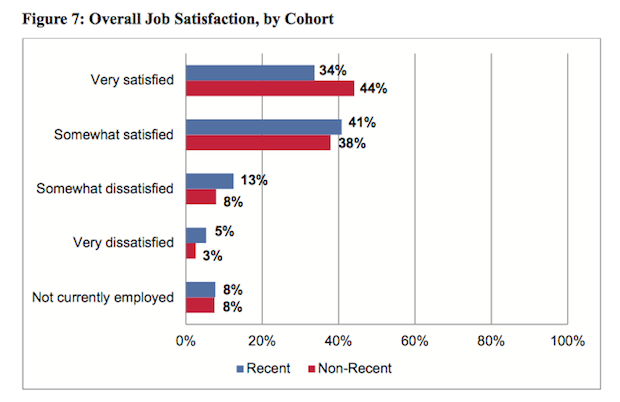Artists Report Back, Animated from BFA MFA PhD on Vimeo.
Does art school lead us to the fulfilling creative life we all hoped, or is it the most expensive possible qualification for a dishwashing job?
Such are the very different pictures of life after art school, painted by two opposing reports: one by the collective of arts alums BFAMFAPhD’s “Artists Report Back”, and another by the Strategic National Arts Alumni Project (SNAAP) “Making It Work”. In the introductory letter, SNAAP Research Director Steven J. Tepper wonders “how we can serve our students and graduates better as they transition from school to work?” BFAMFAPhD asks: “If we are not supporting ourselves as working artists, what jobs do we work?”
A look at the findings: BFAMFAPHD laments shrinking job prospects, and rising costs of art schools (among the most expensive in the country). The study finds that after school, only one in ten alums identifies as an employed “artist” and 6.6% of work in miscellaneous creative fields. The study finds that the largest contingent of alums work managerial jobs. Most shocking of all: according to the study, this country only has around 200,000 working artists with arts-related bachelors degrees.
You can watch the study in video form above. A logical person would read this report and probably decide to save their money.
SNAAP’s “Making It Work”, on the other hand, concludes more optimistically. In the introduction, Research Director Steven Tepper concedes that students take “diverse pathways” in their careers, debt is rising, internships can be a “brick wall”, and less than a quarter of respondents said that their schools helped them acquire financial skills. But overall, the study finds that “graduates have found meaningful employment, are satisfied with their lives, and are pleased that they chose to go to an arts school.”
The Good:
- “[J]ob prospects for new graduates are both good and improving. NACE’s 2014 survey of nearly 44,000 students, representing 696 institutions, found that the percentage of seniors who received at least one job offer by their graduation day increased from 46% in 2013 to 48% in 2014.”
- “The greatest gains were felt by majors in the visual and performing arts, who experienced a 15%-point improvement over the previous year.”
- “Among recent graduates, 69% reported being satisfied with their job security…”
- “In contrast to the traditional archetype of the “starving artist,” the majority of currently employed SNAAP alumni indicated they were satisfied with their income, although a smaller percentage of recent graduates (52%) reported being satisfied than non-recent grads (63%)”
- “[E]very ten currently employed arts graduates described their current jobs as “relevant” or “very relevant” to their training (specifically, 64% of recent alumni and 69% of all alumni)—a greater percentage than graduates from journalism, accounting, or biology majors (National Science Foundation, 2010).”
The Bad:
- “Of the artists who didn’t work in creative fields, 56% responded that there was no artistic work available, and 49% found better paid jobs in other fields”
Interestingly, the study also cites a rising trend in artists who have chosen to remain in the cities they graduated in– now, at 40%.
In any case, the numbers obviously don’t line up. Compare SNAAP’s statistics that 69% of alumni found their jobs relevant to their degree to BFAMFAPhD’s findings that only one in ten alums is a working artist.
This may have to do with where the studies come from. BFAMFAPhD self describes as “a collective of artists, designers, makers, technologists, curators, architects, educators, and analysts” (collective members are Susan Jahoda, Blair Murphy, Caroline Woolard, Vicky Virgin, Julian Boilen; editors are Adam Forman, Tamara Greenfield, Stephen Korns, and Caron Atlas; report graphic designer is Rich Watts). The group has collected its data from the Census Bureau’s 2012 American Community Survey (ACS), “the largest survey that collects data about artists, surveying roughly 1 out of every 100 persons in the nation.” SNAAP surveyed 92,000 arts alums over the course of three years, and is underwritten by 153 participating postsecondary art institutions and art high schools. Meanwhile, the BFAMFAPhD report was created “without monetary support.” Draw your own conclusions.
As for our own findings, the MFA question comes up about once a year on the blog, and we still don’t have a conclusive answer. In 2011, Paddy Johnson surveyed a bunch of her MFA’ed classmates, contrasting salaries from their typically low-paid day jobs (art handler, teacher, gallery assistant) and the perks of the degree (networking, time in the studio, better odds of getting a teaching job). Several years after earning her own MFA, she didn’t think it was worth it.
As for me, I have not gotten an MFA, but some of my classmates from RISD’s 2011 BFA program plan on it. Some are applying to Alfred, the nation’s leading ceramics program, because it’s free and they want to hone their craft. Others plan to go to Germany where Americans get a free ride and rent’s cheap and parties are reportedly better.
I will say this: if the most valuable gain from the degree is the connections you make, then you can be more creative than spending $95,000 to do that. You can interview people, look for assistant gigs on Stephanie Diamond’s Listings Project, take on curatorial projects, start a gallery in a cheap city, and intern, if you must (but don’t waste your time on the duds). Go see as much art as you can. Better-known artists can put their caché to the greater good by showing alongside emerging artists. As BFAMFAPhD recommends, we can start building artist-owned businesses with our friends and low-income neighbors, access equipment through barter and coop networks, turn to “low-cost and free education” beyond elite institutions, and “honor artists and cultural workers who do not have art degrees.” The boldest among you email curators and critics for studio visits. When we have time, we do it.



Comments on this entry are closed.